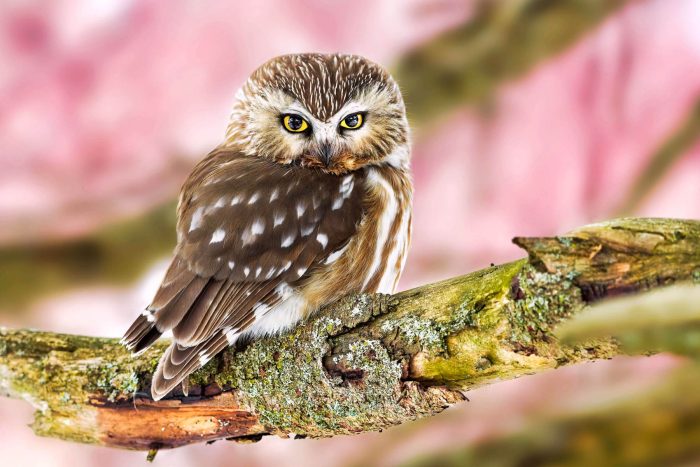Northern Saw-whet Owl
Aegolius acadicus
The elusive saw-whet owl stands at only eight inches tall and hides in Chesapeake forests.
This section shows one large critter image at a time. Use the thumbnails that follow to select a specific image to display here.

This gallery contains a grid of small thumbnails. Selecting a thumbnail will change the main image in the preceding section.
Appearance
Adults are seven to eight inches tall with a fifteen to twenty-inch wingspan. Females are distinguished from males by their larger size. Juvenile saw-whet owls have cinnamon-colored chests and a solid, dark brown back and head with a white “Y” shape between their eyes. Adult saw-whet owls have round heads with a mottled brown and white facial disk and white “Y” between their eyes. Their chest is white with brown specks and their backs are brown with white specks. Both juveniles and adults have bright yellow eyes.
Feeding
Saw-whet owls are completely nocturnal hunters. They most commonly feed on rodents but they will also eat insects, amphibians and small birds. Saw-whet owls in coastal areas will also eat crustaceans.
Predators
Predators of saw-whet owls include larger raptors. Barred owls are one of their main predators.
Flight
Like many owls, saw-whet owls are able to fly almost silently due to their fringed feathers that help air pass through without sound. This adaptation helps owls attack prey without warning.
Voice
Saw-whet owls will call for hours during the spring mating season. The call consists of a “too-too-too” in rhythmic, two-second intervals. This call can be heard up to a half-mile away and nearby males will respond with a lower-pitched version of the song. Saw-whet owls also make whines and squawking noises and will snap their beak when they feel threatened.
Reproduction and life cycle
Males and females will sing to each other when courting in the spring. Saw-whet owls do not build nests but use tree cavities as nesting sites. They prefer to use abandoned woodpecker nests. They compete with boreal owls, starlings and squirrels for their nesting sites and their nests are sometimes destroyed by these competitors. A female will lay five to seven eggs each nesting season. The incubation period takes about 28 days. The female will stay in the nest from when the first egg is laid until the chicks form feathers twenty to thirty days after hatching. Once the chicks develop feathers the female might leave the nest to start hunting or find another male to mate with. The male will stay with the chicks for another month helping them hunt. Saw-whets will nest in cooler watershed states including Pennsylvania, West Virginia and New York. They can sometimes be found nesting in western Maryland in Garrett County.
Did you know?
- Saw-whet owls are the smallest owl in eastern North America. They are only half the size of a screech owl.
- Project Owlnet started in 1994 in Maryland to track and band migrating saw-whet owls. When owls are banded, researchers use blacklights to help determine the age of each owl. The feathers of young saw-whet owls will glow bright pink.
- It is not clear where the saw-whet owl got its name. One theory is that settlers thought the owl’s call sounded like a saw being sharpened on a whet stone. The other theory is that the name came from the French word for owl, “la chouette.”
